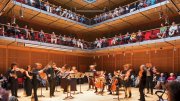A revolution in optical microscopy is enabling biologists to use light to image biological structures at the molecular level, within living cells and organisms—without killing them or chemically fixing them first. Below are some examples of this new technology at work, as demonstrated by video clips from the laboratories of several Harvard researchers. To learn more about how Harvard researchers are further improving—and making use of—advanced optical-microscopy technology, see “Shedding Light on Life,” in this magazine’s May-June issue.'
Elapsed time in video: 210 minutes
Running time of video: 10 seconds
Video clip courtesy of Ji Yu and Jie Xiao. Copyright (c) X. Sunney Xie. All rights reserved. Yu et al. "Probing Gene Expression in Live Cells, One Protein Molecule at a Time," Science, 311, 1600-1603 (2006)
Professor of chemistry X. Sunney Xie and his team investigate how individual molecules are born and interact with other molecules in a live cell. Watch a time-lapse movie of multiplying E. coli cells that divide over the course of 55 minutes. Protein production is monitored one molecule at a time. Each yellow flash in the fluorescent overlay is due to a single newly born fluorescent protein molecule. To read more about Professor Xie’s research, visit his website at: https://bernstein.harvard.edu.
Running time of video: 50 seconds
Video used by permission of the Kirchhausen Lab at the Immune Disease Institute. All rights reserved.
Professor of cell biology Tom Kirchhausen studies how things get in and out of cells. His lab has been investigating the precise structure and function of clathrin, a protein that helps deform the cell membrane as it forms the outer coat of vesicles (microscopic capsules that capture cargo and take it into the cell). Watch as a low-density lipoprotein is captured by a forming clathrin-coated vesicle and taken into a cell. To read more about Professor Kirchhausen’s research, visit his website at: www.cbrinstitute.org/labs/kirchhausen/research.html
Elapsed time in video: 56 minutes
Running time of video: 5 seconds
Supplemental media for Bishop DL, Misgeld T, Walsh MK, Gan WB, Lichtman JW. “Axon Branch Removal at Developing Synapses by Axosome Shedding. ”Neuron. 2004 44:651-661.
Professor of molecular and cellular biology Jeff Lichtman’s lab has developed techniques for observing the web of connections in the living brain and watching them change over time. Watch a bulb-tipped axon (the threadlike part of a nerve cell that conducts impulses outward from the cell body) that glows pale blue retreat from another axon, glowing green. For more details about this video and Professor Lichtman’s research, visit his website at: www.mcb.harvard.edu/Lichtman/Bishop and his page at www.mcb.harvard.edu/faculty/Lichtman.html
Elapsed time in video: 80 seconds
Running time of video: 16 seconds
Copyright (c) Yeang Ch'ng, Kenichi Ohki, and Clay Reid. All rights reserved.
Professor of neurobiology R. Clay Reid studies the brain’s visual system. Watch different neurons firing when a rat looks at lines oriented in different directions. For more details about this video and Professor Reid’s research, visit his website at: https://reid.med.harvard.edu/overview.html
Elapsed time in video: 11.5 minutes
Running time of video: 4.5 seconds
Copyright von Andrian Lab. All rights reserved. This video was originally published as supplementary information to Mempel et al. Nature 427: 154-159, 2004.
Mallinckrodt professor of immunopathology Ulrich von Andrian specializes in “intravital” microscopy, which images events in living animals. Watch dendritic cells (red), which help trigger the immune response, interact with immune system T cells (green) within lymph nodes. For more details about this video and Professor von Andrian’s research, visit his website at: www.cbr.med.harvard.edu/labs/vonandrian/Pages/Videos%20Page.html








